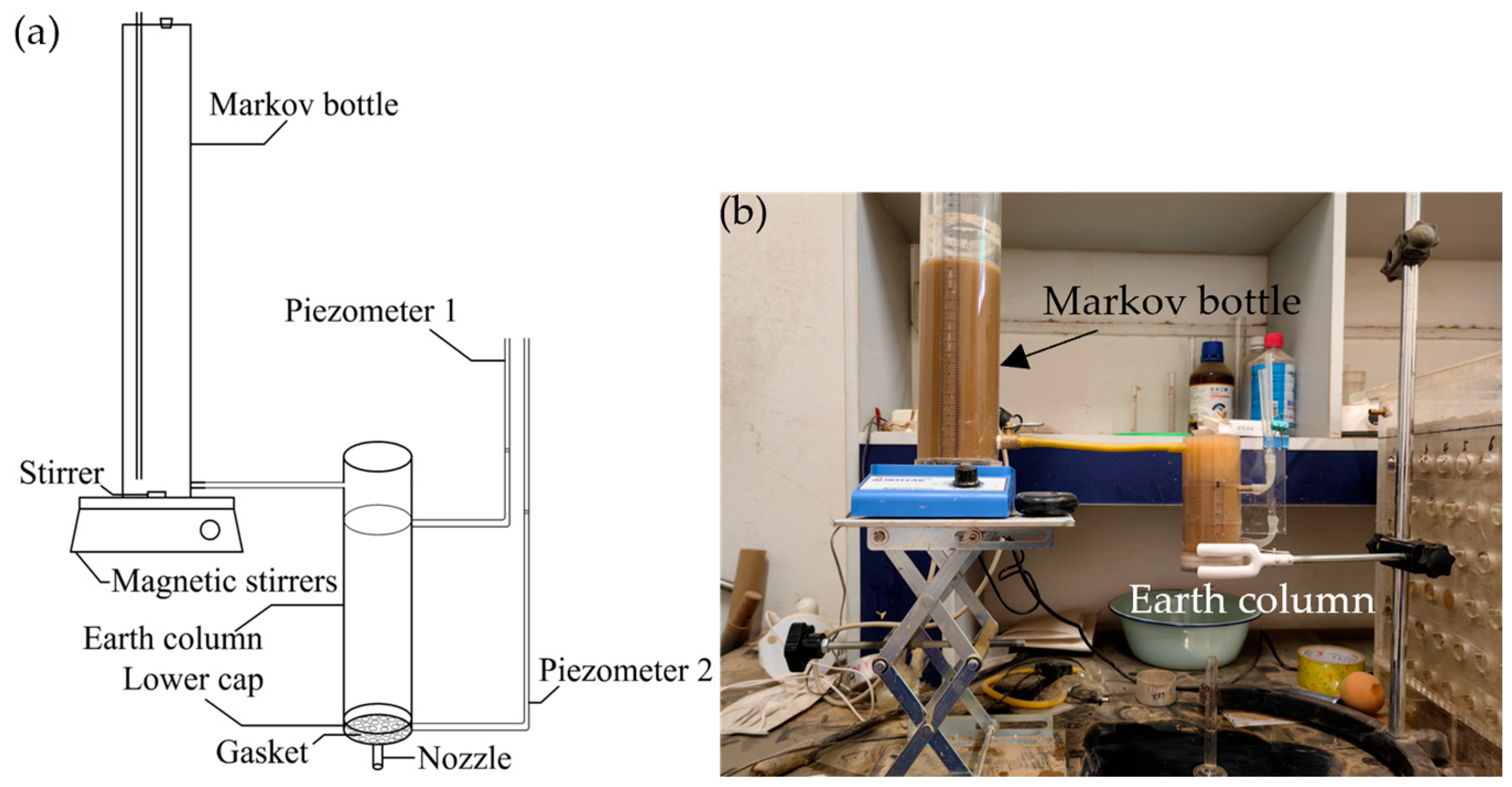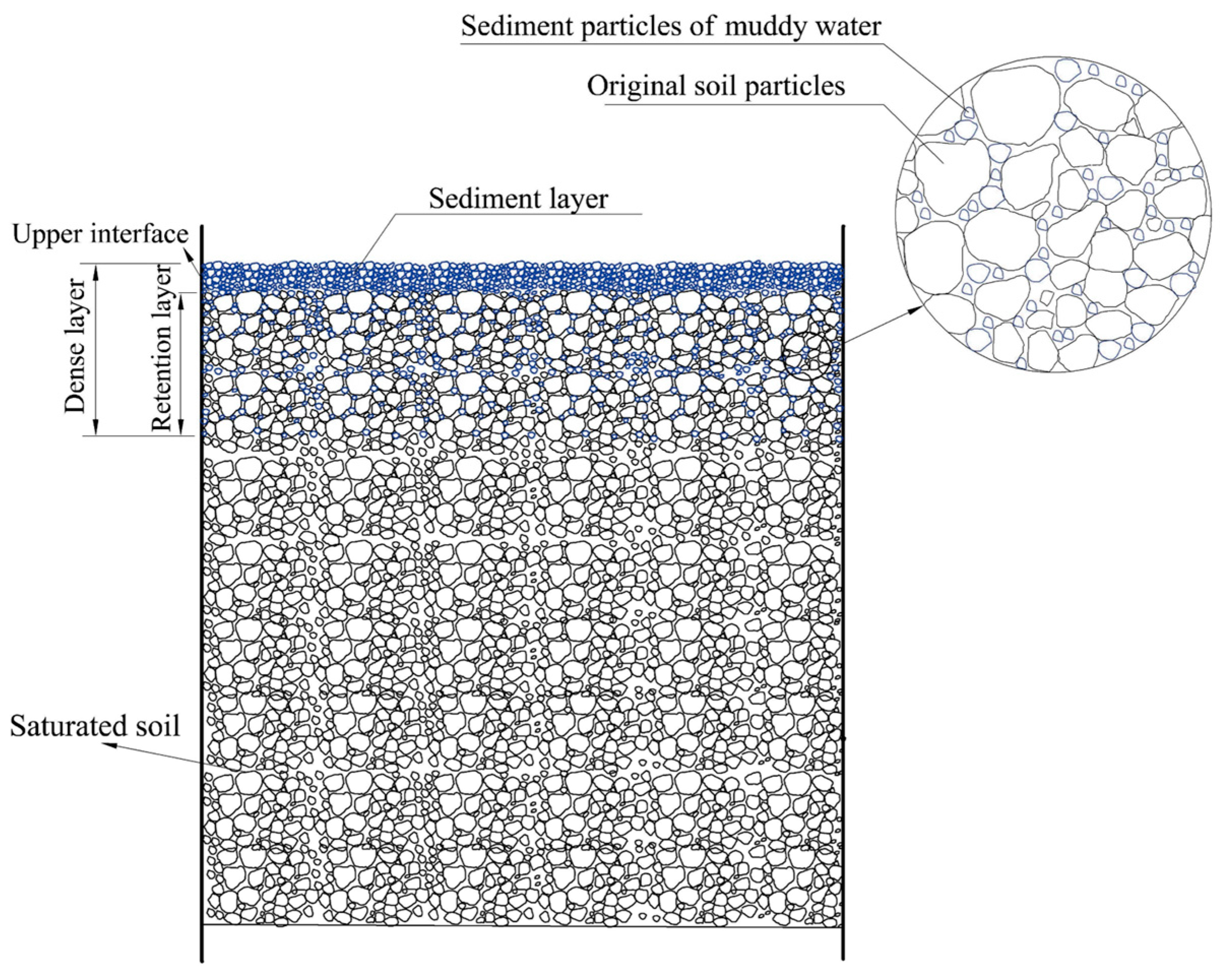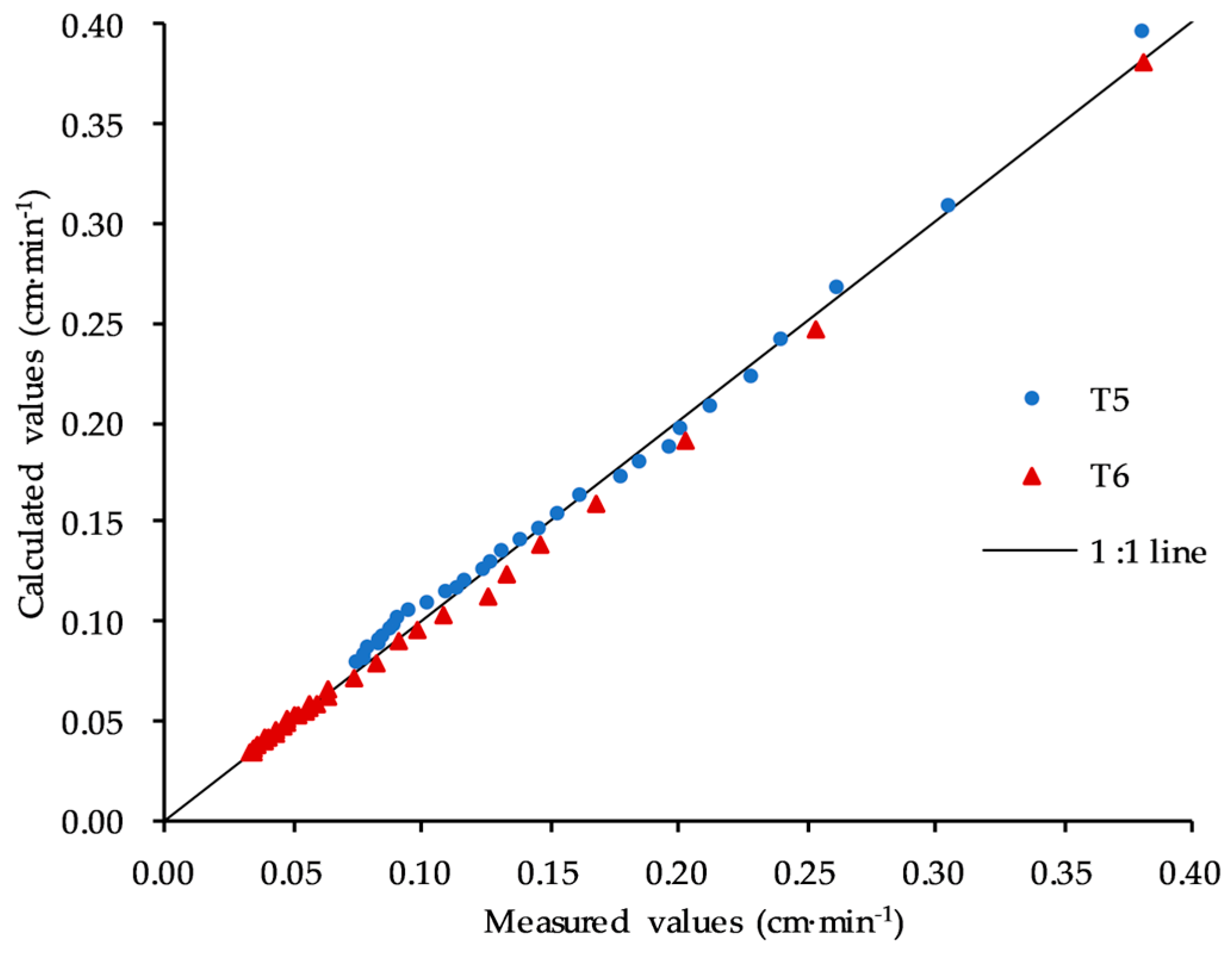Effects of Muddy Water Infiltration on the Hydraulic Conductivity of Soils
Abstract
1. Introduction
2. Materials and Methods
2.1. Test Materials
2.2. Test Setup and Methods
2.3. Experimental Design
2.4. Analysis of Data
3. Results
3.1. Effect of Soil Texture on Hydraulic Conductivity
3.2. Effect of Muddy Water Sand Content on Hydraulic Conductivity
3.3. Simulation Analysis and Verification
3.4. Effect of Muddy Water Sand Content on the Average Rate of Change of Hydraulic Conductivity
3.5. Effect of Muddy Water Sand Content on Cumulative Infiltration
4. Discussion
5. Conclusions
Author Contributions
Funding
Data Availability Statement
Conflicts of Interest
References
- Albers, L.T.; Schyns, J.F.; Booij, M.J.; Zhuo, L. Blue Water Footprint Caps per Sub-Catchment to Mitigate Water Scarcity in a Large River Basin: The Case of the Yellow River in China. J. Hydrol. 2021, 603, 126992. [Google Scholar] [CrossRef]
- Zhao, X.; Xia, H.; Pan, L.; Song, H.; Niu, W.; Wang, R.; Li, R.; Bian, X.; Guo, Y.; Qin, Y. Drought Monitoring over Yellow River Basin from 2003–2019 Using Reconstructed MODIS Land Surface Temperature in Google Earth Engine. Remote Sens. 2021, 13, 3748. [Google Scholar] [CrossRef]
- Xie, M.; Ren, Z.; Li, Z.; Zhang, X.; Ma, X.; Li, P.; Shen, Z. Evolution of the Precipitation-Stream Runoff Relationship in Different Precipitation Scenarios in the Yellow River Basin. Urban Clim. 2023, 51, 101609. [Google Scholar] [CrossRef]
- Zhong, D.; Dong, Z.; Fu, G.; Bian, J.; Kong, F.; Wang, W.; Zhao, Y. Trend and Change Points of Streamflow in the Yellow River and Their Attributions. J. Water Clim. Chang. 2021, 12, 136–151. [Google Scholar] [CrossRef]
- Ye, Z.; Miao, P.; Li, N.; Wang, Y.; Meng, F.; Zhang, R.; Yin, S. Dynamic Relationship between Agricultural Water Use and the Agricultural Economy in the Inner Mongolia Section of the Yellow River Basin. Sustainability 2023, 15, 12979. [Google Scholar] [CrossRef]
- Zhang, F.; Jin, G.; Liu, G. Evaluation of Virtual Water Trade in the Yellow River Delta, China. Sci. Total Environ. 2021, 784, 147285. [Google Scholar] [CrossRef] [PubMed]
- Zhang, B.; Niu, N.; Li, H.; Tao, H.-W.; Wang, Z.-H. Mapping the Virtual Water Trade in Water-Scarce Basin: An Environmentally Extended Input-Output Analysis in the Yellow River Basin of China. Environ. Sci. Pollut. Res. 2023, 30, 118396–118409. [Google Scholar] [CrossRef] [PubMed]
- Lu, W.; Guo, X.; Liu, W.; Du, R.; Chi, S.; Zhou, B. Spatial-Temporal Dynamic Evolution and Influencing Factors of Green Efficiency of Agricultural Water Use in the Yellow River Basin, China. Water 2023, 15, 143. [Google Scholar] [CrossRef]
- Wang, K.; Zhou, J.; Tan, M.L.; Lu, P.; Xue, Z.; Liu, M.; Wang, X. Impacts of Vegetation Restoration on Soil Erosion in the Yellow River Basin, China. Catena 2024, 234, 107547. [Google Scholar] [CrossRef]
- Zhao, H.; Lin, Y.; Zhou, J.; Delang, C.O.; He, H. Simulation of Holocene Soil Erosion and Sediment Deposition Processes in the Yellow River Basin during the Holocene. Catena 2022, 219, 106600. [Google Scholar] [CrossRef]
- Xiao, Y.; Guo, B.; Lu, Y.; Zhang, R.; Zhang, D.; Zhen, X.; Chen, S.; Wu, H.; Wei, C.; Yang, L.; et al. Spatial-Temporal Evolution Patterns of Soil Erosion in the Yellow River Basin from 1990 to 2015: Impacts of Natural Factors and Land Use Change. Geomat. Nat. Hazards Risk 2021, 12, 103–122. [Google Scholar] [CrossRef]
- Zhao, H.; Zhang, F.; Yu, Z.; Li, J. Spatiotemporal Variation in Soil Degradation and Economic Damage Caused by Wind Erosion in Northwest China. J. Environ. Manag. 2022, 314, 115121. [Google Scholar] [CrossRef] [PubMed]
- Wang, S.; Wang, X. Changes in Water and Sediment Processes in the Yellow River and Their Responses to Ecological Protection during the Last Six Decades. Water 2023, 15, 2285. [Google Scholar] [CrossRef]
- Zhang, J.; Han, Y.; Wang, X.; Bian, H. Experimental Investigation of the Dynamic Characteristics of Treated Silt Using Lignin: Case Study of Yellow River Flood Basin. Int. J. Geomech. 2021, 21, 04021056. [Google Scholar] [CrossRef]
- Wang, Y.; Wang, Z.; Chen, Y.; Cao, T.; Yu, X.; Rui, P. Experimental Study on Bio-Treatment Effect of the Dredged Yellow River Silt Based on Soybean Urease Induced Calcium Carbonate Precipitation. J. Build. Eng. 2023, 75, 106943. [Google Scholar] [CrossRef]
- Wu, X.; Feng, X.; Fu, B.; Yin, S.; He, C. Managing Erosion and Deposition to Stabilize a Silt-Laden River. Sci. Total Environ. 2023, 881, 163444. [Google Scholar] [CrossRef] [PubMed]
- Jia, C.; Allinson, G.; Bai, X.; Gong, Z.; Li, X. Comparison of the Leaching Characteristics of Magnesium-Rich Dust-Polluted Soil in Northeast China Treated with PAM and Citric Acid. J. Soils Sediments 2023, 23, 2083–2095. [Google Scholar] [CrossRef]
- Cui, Z.; Huang, Z.; Luo, J.; Qiu, K.; Lopez-Vicente, M.; Wu, G.-L. Litter Cover Breaks Soil Water Repellency of Biocrusts, Enhancing Initial Soil Water Infiltration and Content in a Semi-Arid Sandy Land. Agric. Water Manag. 2021, 255, 107009. [Google Scholar] [CrossRef]
- Liao, Y.; Dong, L.; Li, A.; Lv, W.; Wu, J.; Zhang, H.; Bai, R.; Liu, Y.; Li, J.; Shangguan, Z.; et al. Soil Physicochemical Properties and Crusts Regulate the Soil Infiltration Capacity after Land-Use Conversions from Farmlands in Semiarid Areas. J. Hydrol. 2023, 626, 130283. [Google Scholar] [CrossRef]
- Sun, F.; Xiao, B.; Kidron, G.J. Towards the Influences of Three Types of Biocrusts on Soil Water in Drylands: Insights from Horizontal Infiltration and Soil Water Retention. Geoderma 2022, 428, 116136. [Google Scholar] [CrossRef]
- Atashpaz, B.; Khormali, F.; Malekzadeh, E.; Soleymanzadeh, M. Evaluating the Effect of Different Sequences of Biological Crusts on Loess Derived Soil Biophysiological Properties in the Semi-Arid Regions of Northern Iran. J. Soil Sci. Plant Nutr. 2023, 23, 6777–6787. [Google Scholar] [CrossRef]
- Negyesi, G.; Szabo, S.; Buro, B.; Mohammed, S.; Loki, J.; Rajkai, K.; Holb, I.J. Influence of Soil Moisture and Crust Formation on Soil Evaporation Rate: A Wind Tunnel Experiment in Hungary. Agronomy 2021, 11, 935. [Google Scholar] [CrossRef]
- Jiang, R.; Fei, L.; Kang, S. Water and Nitrogen Transport Characteristics of Single-Line Interference Infiltration under Film Hole Irrigation with Muddy Water and Fertilizer. J. Drain. Irrig. Mach. Eng. 2022, 40, 496–503. [Google Scholar] [CrossRef]
- Liu, L.; Fei, L.; Chen, L.; Hao, K.; Zhang, Q. Effects of Initial Soil Moisture Content on Soil Water and Nitrogen Transport under Muddy Water Film Hole Infiltration. Int. J. Agric. Biol. Eng. 2021, 14, 182–189. [Google Scholar] [CrossRef]
- Zhong, Y.; Fei, L.; Zhu, S.; He, J.; Kang, S. Effect of Sediment Concentration of Muddy Water on One-Dimensional Vertical Infiltration Characteristics and Dense Layer Formation Characteristics. Soils 2022, 54, 602–609. [Google Scholar] [CrossRef]
- Nasirian, A.; Maghrebi, M.F.; Mohtashami, A. Numerical and Experimental Assessment of Suspended Material Effects on Water Loss Reduction from Irrigation Channels. Iran. J. Sci. Technol.-Trans. Civ. Eng. 2022, 46, 2483–2493. [Google Scholar] [CrossRef]
- Rumynin, V.G.; Sindalovskiy, L.N.; Nikulenkov, A.M. Analytical Solutions for Flow and Advective Solute Transport in Unconfined Watershed Aquifers with Depth-Dependent Hydraulic Conductivity. J. Hydrol. 2021, 603, 127116. [Google Scholar] [CrossRef]
- Iden, S.C.; Blocher, J.R.; Diamantopoulos, E.; Durner, W. Capillary, Film, and Vapor Flow in Transient Bare Soil Evaporation (1): Identifiability Analysis of Hydraulic Conductivity in the Medium to Dry Moisture Range. Water Resour. Res. 2021, 57, e2020WR028513. [Google Scholar] [CrossRef]
- O’Keeffe, A.; Shrestha, D.; Dunkel, C.; Brooks, E.; Heinse, R. Modeling Moisture Redistribution from Selective Non-Uniform Application of Biochar on Palouse Hills. Agric. Water Manag. 2023, 277, 108026. [Google Scholar] [CrossRef]
- Rabouli, S.; Serre, M.; Dubois, V.; Gance, J.; Henine, H.; Molle, P.; Truffert, C.; Delgado-Gonzalez, L.; Clement, R. Spatialization of Saturated Hydraulic Conductivity Using the Bayesian Maximum Entropy Method: Application to Wastewater Infiltration Areas. Water Res. 2021, 204, 117607. [Google Scholar] [CrossRef]
- Obour, P.B.; Ugarte, C.M. A Meta-Analysis of the Impact of Traffic-Induced Compaction on Soil Physical Properties and Grain Yield. Soil Tillage Res. 2021, 211, 105019. [Google Scholar] [CrossRef]
- Chen, L.; Ming, F.; Zhang, X.; Wei, X.; Liu, Y. Comparison of the Hydraulic Conductivity between Saturated Frozen and Unsaturated Unfrozen Soils. Int. J. Heat Mass Transf. 2021, 165, 120718. [Google Scholar] [CrossRef]
- Ferreira, T.R.; Archilha, N.L.; Cassaro, F.A.M.; Pires, L.F. How Can Pore Characteristics of Soil Aggregates from Contrasting Tillage Systems Affect Their Intrinsic Permeability and Hydraulic Conductivity? Soil Tillage Res. 2023, 230, 105704. [Google Scholar] [CrossRef]
- Seyedsadr, S.; Sipek, V.; Jacka, L.; Snehota, M.; Beesley, L.; Pohorely, M.; Kovar, M.; Trakal, L. Biochar Considerably Increases the Easily Available Water and Nutrient Content in Low-Organic Soils Amended with Compost and Manure. Chemosphere 2022, 293, 133586. [Google Scholar] [CrossRef]
- Francos, N.; Chabrillat, S.; Tziolas, N.; Milewski, R.; Brell, M.; Samarinas, N.; Angelopoulou, T.; Tsakiridis, N.; Liakopoulos, V.; Ruhtz, T.; et al. Estimation of Water-Infiltration Rate in Mediterranean Sandy Soils Using Airborne Hyperspectral Sensors. Catena 2023, 233, 107476. [Google Scholar] [CrossRef]
- Tzimopoulos, C.; Papadopoulos, K.; Samarinas, N.; Papadopoulos, B.; Evangelides, C. Fuzzy Finite Elements Solution Describing Recession Flow in Unconfined Aquifers. Hydrology 2024, 11, 47. [Google Scholar] [CrossRef]
- Dong, L.; Zhang, W.; Xiong, Y.; Zou, J.; Huang, Q.; Xu, X.; Ren, P.; Huang, G. Impact of Short-Term Organic Amendments Incorporation on Soil Structure and Hydrology in Semiarid Agricultural Lands. Int. Soil Water Conserv. Res. 2022, 10, 457–469. [Google Scholar] [CrossRef]
- Ming, F.; Pei, W.; Zhang, M.; Chen, L. A Hydraulic Conductivity Model of Frozen Soils with the Consideration of Water Films. Eur. J. Soil Sci. 2022, 73, e13210. [Google Scholar] [CrossRef]
- Sun, F.; Xiao, B.; Kidron, G.J.; Heitman, J.L. Insights about Biocrust Effects on Soil Gas Transport and Aeration in Drylands: Permeability, Diffusivity, and Their Connection to Hydraulic Conductivity. Geoderma 2022, 427, 116137. [Google Scholar] [CrossRef]
- Freeze, R.A. Henry Darcy and the Fountains of Dijon. Groundwater 2010, 32, 23–30. [Google Scholar] [CrossRef]
- Mao, H.; Zhang, C.; He, T.; Gu, Y. Influences of Seepage of Muddy Water on the Permeability of Coarse-Grained Soil. Trans. Chin. Soc. Agric. Eng. 2022, 38, 140–150. [Google Scholar] [CrossRef]
- Kostiakov, A.N. On the Dynamics of the Coefficient of Water-Percolation in Soils and on the Necessity of Studying It from a Dynamic Point of View for Purposes of Amelioration. In Proceedings of the Transactions of 6th Committee International Society of Soil Science, Moscow, Russia, 1932; pp. 17–21. [Google Scholar]
- Wang, H.; Sun, H.; Huang, Z.; Ge, X. A Microstructural Investigation on Hydraulic Conductivity of Soft Clay. Bull. Eng. Geol. Environ. 2021, 80, 4067–4078. [Google Scholar] [CrossRef]
- Zheng, W.; Hu, X.; Tannant, D.D.; Zhou, B. Quantifying the Influence of Grain Morphology on Sand Hydraulic Conductivity: A Detailed Pore-Scale Study. Comput. Geotech. 2021, 135, 104147. [Google Scholar] [CrossRef]
- Wen, T.; Chen, X.; Luo, Y.; Shao, L.; Niu, G. Three-Dimensional Pore Structure Characteristics of Granite Residual Soil and Their Relationship with Hydraulic Properties under Different Particle Gradation by X-Ray Computed Tomography. J. Hydrol. 2023, 618, 129230. [Google Scholar] [CrossRef]
- Zhai, Q.; Rahardjo, H.; Satyanaga, A.; Zhu, Y.; Dai, G.; Zhao, X. Estimation of Wetting Hydraulic Conductivity Function for Unsaturated Sandy Soil. Eng. Geol. 2021, 285, 106034. [Google Scholar] [CrossRef]
- Ghanbarian, B. Unsaturated Hydraulic Conductivity in Dual-Porosity Soils: Percolation Theory. Soil Tillage Res. 2021, 212, 105061. [Google Scholar] [CrossRef]
- Sun, F.; Xiao, B.; Li, S.; Yu, X.; Kidron, G.J.; Heitman, J. Direct Evidence and Mechanism for Biocrusts-Induced Improvements in Pore Structure of Dryland Soil and the Hydrological Implications. J. Hydrol. 2023, 623, 129846. [Google Scholar] [CrossRef]
- Shi, W.; Pan, Y.; Zhang, Y.; Hu, R.; Wang, X. The Effect of Different Biocrusts on Soil Hydraulic Properties in the Tengger Desert, China. Geoderma 2023, 430, 116304. [Google Scholar] [CrossRef]
- Wang, Y.-B.; Huang, Z.; Qian, J.-X.; Li, T.; Luo, J.; Li, Z.; Qiu, K.; Lopez-Vicente, M.; Wu, G.-L. Freeze-Thaw Cycles Aggravated the Negative Effects of Moss-Biocrusts on Hydraulic Conductivity in Sandy Land. Catena 2021, 207, 105638. [Google Scholar] [CrossRef]
- Zambon, N.; Johannsen, L.L.; Strauss, P.; Dostal, T.; Zumr, D.; Cochrane, T.A.; Klik, A. Splash Erosion Affected by Initial Soil Moisture and Surface Conditions under Simulated Rainfall. Catena 2021, 196, 104827. [Google Scholar] [CrossRef]
- Qiu, D.; Xiao, B.; Kidron, G.J. Ecohydrological Influences of Biocrusts and Their Pathways in a Desert Steppe Ecosystem. Ecohydrology 2023, 16, e2581. [Google Scholar] [CrossRef]







| Material | Particle Composition/% | Texture | Organic Matter/(g·kg−1) | Bulk Density (g·cm−3) | ||
|---|---|---|---|---|---|---|
| <0.002 mm | 0.002~<0.02 mm | 0.02~2 mm | ||||
| Soil | 9.46 | 53.66 | 36.88 | Silt loam | 7.24 | 1.35 |
| 4.87 | 21.21 | 73.92 | Sandy loam | 7.64 | 1.40 | |
| 1.04 | 6.50 | 92.46 | Sand | 11.86 | 1.76 | |
| Sediment in muddy water | 4.22 | 42.14 | 53.64 | |||
| Item | Sediment Characteristic | ||||||
|---|---|---|---|---|---|---|---|
| Physical Properties | Chemical Properties | ||||||
| Median Diameter/mm | Coefficient of Uniformity | Mean Diameter/mm | Na+/ (g·kg−1) | Ca2+/ (g·kg−1) | pH | Organic Matter /(g·kg−1) | |
| Values | 0.023 | 10.41 | 0.029 | 0.19 | 0.05 | 7.50 | 4.32 |
| Treatment | Soil Texture | Sand Content/% | Note |
|---|---|---|---|
| F1 | Silt loam | 6 | Soil texture |
| F2 | Sandy loam | ||
| T2 | Sand | ||
| T1 | Sandy soil | 3 | Sand content |
| T2 | 6 | ||
| T3 | 9 | ||
| T4 | 12 | ||
| T5 | Sandy soil | 4 | Verification tests |
| T6 | 10 |
| Soil Texture | Average Values/ (cm·min−1) | Coefficients of Variation/% | p-Values of Sources of Variation | Least Significant Difference Values/ (cm·min−1) | Significant Difference | |
|---|---|---|---|---|---|---|
| Sandy soil | 0 min | 0.3823 | 0.07 | 0.00 * | 0.00100 | * |
| 20 min | 0.0709 | 0.42 | * | |||
| 30 min | 0.0382 | 1.05 | * | |||
| Silt loam | 0 min | 0.0034 | 1.62 | 0.00 * | 0.00018 | * |
| 20 min | 0.0032 | 0.95 | * | |||
| 30 min | 0.0030 | 1.17 | * | |||
| Sandy loam | 0 min | 0.0124 | 1.62 | 0.00 * | 0.00003 | * |
| 20 min | 0.0116 | 0.95 | * | |||
| 30 min | 0.0109 | 1.17 | * | |||
| Treatment | Sand Content/% | a | b | R2 | RMSE | c | d | R2 | RMSE |
|---|---|---|---|---|---|---|---|---|---|
| T1 | 3 | 0.4005 | −0.1965 | 0.9150 | 0.7764 | −0.0848 | 0.4430 | 0.9856 | 0.0300 |
| T2 | 6 | 0.3951 | −0.6102 | 0.9800 | 0.2129 | −0.0214 | 0.1302 | 0.9794 | 0.0016 |
| T3 | 9 | 0.3716 | −0.7390 | 0.9445 | 0.1472 | −0.0193 | 0.1176 | 0.9910 | 0.0006 |
| T4 | 12 | 0.3705 | −0.8182 | 0.9577 | 0.1256 | −0.0090 | 0.0677 | 0.9042 | 0.0001 |
| Fitting Parameter | Fitting Function | R2 | RMSE |
|---|---|---|---|
| a | 0.8832 | 0.0054 | |
| b | 0.8661 | 0.1012 | |
| c | 0.9802 | 0.0056 | |
| d | 0.9749 | 0.0320 |
| Treatment | Sand Content/% | p | q | R2 | RMSE |
|---|---|---|---|---|---|
| T1 | 3 | 0.0348 | −0.4740 | 0.9763 | 0.0007 |
| T2 | 6 | 0.1968 | −0.8610 | 0.9842 | 0.0027 |
| T3 | 9 | 0.2200 | −0.8820 | 0.9315 | 0.0079 |
| T4 | 12 | 0.2272 | −0.8840 | 0.9495 | 0.0075 |
| Treatment | Sand Content/% | α | β | R2 | RMSE |
|---|---|---|---|---|---|
| T1 | 3 | 0.8810 | 0.7394 | 0.9859 | 0.9884 |
| T2 | 6 | 0.6432 | 0.6230 | 0.9521 | 0.4972 |
| T3 | 9 | 0.6327 | 0.5564 | 0.9893 | 0.0758 |
| T4 | 12 | 0.5441 | 0.5426 | 0.9881 | 0.0723 |
Disclaimer/Publisher’s Note: The statements, opinions and data contained in all publications are solely those of the individual author(s) and contributor(s) and not of MDPI and/or the editor(s). MDPI and/or the editor(s) disclaim responsibility for any injury to people or property resulting from any ideas, methods, instructions or products referred to in the content. |
© 2024 by the authors. Licensee MDPI, Basel, Switzerland. This article is an open access article distributed under the terms and conditions of the Creative Commons Attribution (CC BY) license (https://creativecommons.org/licenses/by/4.0/).
Share and Cite
Kang, S.; Fei, L.; Yang, Z.; Zhao, P.; Wang, Q.; Fan, Q.; Liu, L. Effects of Muddy Water Infiltration on the Hydraulic Conductivity of Soils. Agronomy 2024, 14, 1545. https://doi.org/10.3390/agronomy14071545
Kang S, Fei L, Yang Z, Zhao P, Wang Q, Fan Q, Liu L. Effects of Muddy Water Infiltration on the Hydraulic Conductivity of Soils. Agronomy. 2024; 14(7):1545. https://doi.org/10.3390/agronomy14071545
Chicago/Turabian StyleKang, Shouxuan, Liangjun Fei, Zhen Yang, Penghui Zhao, Qian Wang, Qianwen Fan, and Lihua Liu. 2024. "Effects of Muddy Water Infiltration on the Hydraulic Conductivity of Soils" Agronomy 14, no. 7: 1545. https://doi.org/10.3390/agronomy14071545
APA StyleKang, S., Fei, L., Yang, Z., Zhao, P., Wang, Q., Fan, Q., & Liu, L. (2024). Effects of Muddy Water Infiltration on the Hydraulic Conductivity of Soils. Agronomy, 14(7), 1545. https://doi.org/10.3390/agronomy14071545




